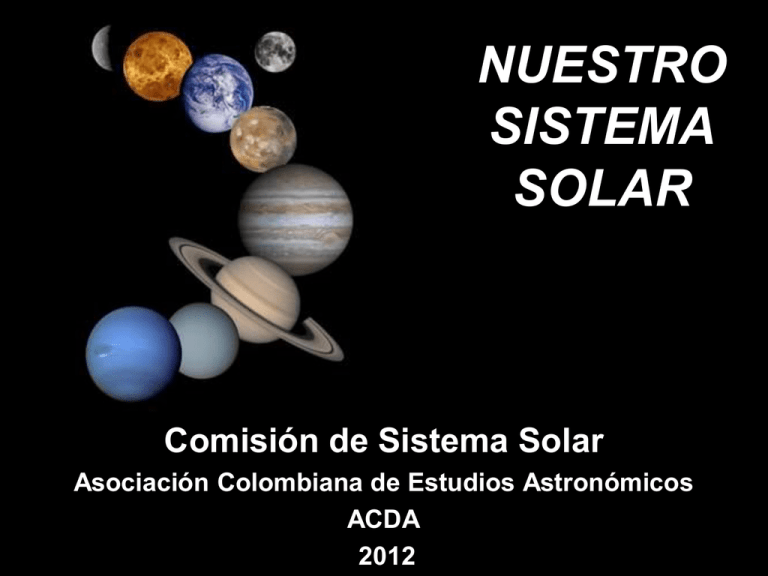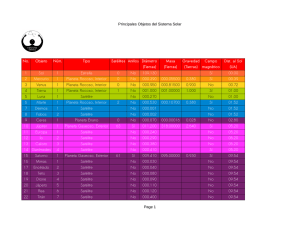NUESTRO SISTEMA SOLAR
Anuncio

NUESTRO SISTEMA SOLAR Comisión de Sistema Solar Asociación Colombiana de Estudios Astronómicos ACDA 2012 COMPONENTES DE LA NEBULOSA SOLAR DIFERENCIACIÓN VERTICAL CRATERIZACIÓN UNIDAD ASTRONÓMICA 1 unidad astronómica = 1 UA = 150.000.000 Km INCLINACIÓN ORBITAL PLANETA DIÁMETRO MASA DENSIDAD Mercurio 0.38 0.06 5.4 Venus 0.95 0.85 5.3 Tierra 1.00 1.00 5.5 Marte 0.53 0.11 4.0 Júpiter 10.8 318 1.33 Saturno 8.9 95 0.68 Urano 4.1 15 1.2 Neptuno 3.8 17 1.7 Plutón 0.2 0.002 2.1 PLANETAS VS. LUNAS FUSIÓN NUCLEAR ESTELAR Cadena protón protón PLANETA DIÁMETRO MASA DENSIDAD Mercurio 0.38 0.06 5.4 Venus 0.95 0.85 5.3 Tierra 1.00 1.00 5.5 Marte 0.53 0.11 4.0 Plutón 0.2 0.002 2.1 Planetas craterizados AGUA: TRES ESTADOS ZONAS CRATERIZADAS PLANETA DIÁMETRO MASA DENSIDAD Tierra 1.00 1.00 5.5 Júpiter 10.8 318 1.33 Saturno 8.9 95 0.68 Urano 4.1 15 1.2 Neptuno 3.8 17 1.7 INTERIOR DE JÚPITER Y SATURNO ATMÓSFERAS JOVIANAS LUNAS DEL SISTEMA SOLAR 2011 PLANETA LUNAS Mercurio 0 Venus 0 PLANETAS ENANOS LUNAS Tierra 1 Ceres 0 Marte 2 Plutón 4 Júpiter 64 Makemake 0 Saturno 62 Haumea 2 Urano 27 Eris 1 Neptuno 13 No total de lunas 176 ANILLO DE JUPITER PLUTINOS PLANETAS EXTRASOLARES Agosto de 2012 • 623 Sistemas planetarios – 105 Sistemas múltiples • 777 Planetas BIBLIOGRAFÍA • Wagner J.F., Introduction to the Solar System, 2001, International Thomson Publishing, 2nd edition. • Beatty J.K., Petersen C.C., Chaikin A., The new Solar System, 1998, Cambridge University Press; 4th edition • Weissman P.R., McFadden L. Johnson T.V., Encyclopedia of the Solar System, 2007, Academic Press, 2nd edition. • Seeds M., The Solar System, 2008, Thomson Brooks/Cole, Sixth edition. • • • • http://es.wikipedia.org/wiki/Sistema_Solar http://www.solarviews.com/span/solarsys.htm http://solarsystem.jpl.nasa.gov/planets/index.cfm http://science.nationalgeographic.com/science/space/solar-system
